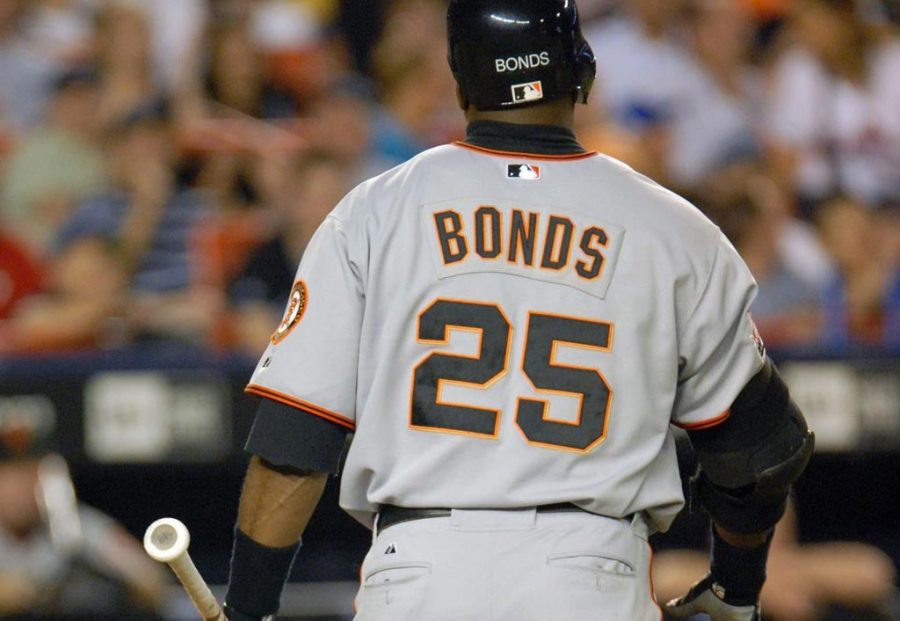Barry Bonds is a Hall of Famer, maybe
Barry Bonds induction into the MLB’s most prestigious honor is hampered by his steroid use, despite unmatched on-field performance.
January 18, 2022
For as long as the game of baseball has been played, some form of rules have been in place. And, for as long as there have been rules, there have been “cheaters,” players who operate just outside of rules, whether through loopholes or just blatant rule breaking. Some of these players or teams are heralded as heroes of the game, even earning the highest honor in the sport: being inducted into the Baseball Hall of Fame. Case in point: Hank Greenberg and his World Champion Detroit Tigers, who used an elaborate sign-stealing system to get the edge over opponents. Others are unjustly regarded as villains, who ruined the integrity of the game-perhaps most notorious of all being the steroid users of the late 1990s and early 2000s, most notably Barry Bonds. There is a strong case for Bonds to join the Baseball Hall of Fame, but there are also those in the game who do not want Bonds to receive this recognition because he used steroids.
Bonds is a Hall of Famer. Statistically, no player has ever achieved the levels he has. For reference, here are are just a few of Bonds’s feats: 40+ stolen bases and 40+ home runs in a season, 73 home runs in a season (a record that still stands), 762 career home runs, which is the most ever, and finally, as a testament to his intimidation as well as his discipline at the plate, he is the all-time leader in career walks, 2558 in 9847 at-bats. Based on these statistical accomplishments, Bonds is a Hall of Famer, but there is one moral issue that makes many baseball writers hesitate when it comes time to vote Barry into the Hall.
The issue resides in the fact that Bonds used performance enhancing drugs. He used a wide range of steroids including two designer steroids referred to as “the Cream and the Clear,” as well as insulin, human growth hormone, testosterone decanoate, and trenbolone, a steroid created to improve the muscle quality of cattle. He wasn’t simply dabbling, Bonds was on a full cycle. This alone is enough to make many older writers not vote for him, but what makes many hesitate is the fact that Bonds testified in front of a grand jury in 2003 and committed perjury by claiming he did not use steroids, which eventually came to a head when a positive steroid test surfaced. Bonds was inevitably found guilty of obstructing justice in 2011, but all of this may be beside the point.
The point of the Baseball Hall of Fame, in many opinions around baseball, is to present the history of the sport. That being said, one is unable to tell the story of baseball without mentioning the name of Barry Bonds. His on-field performance is no doubt tarnished by his steroid use but a person cannot do what he did with steroids alone. Take, for instance, Jose Conseco. A fellow steroid user, Jose, although quite the player, never put up the numbers Barry was recording. Baseball is not a sport that one can succeed in by simply being strong; There is a large degree of skill involved. Bonds’s number of career walks are a testament to the skill he had. Also, at the major league level, one cannot just swing hard in the middle of the zone and succeed; again, it takes a large degree of skill. Both of these points only reinforce the idea that Bonds is a Hall of Famer. It is conceptually impossible to tell the story of baseball without Barry Bonds.
It is also worth mentioning that Bonds, as well as other players during the steroid era, saved baseball. In 1994, the MLB players union, the MLBPA, went on strike. It was the first, and only, time a professional sport has missed an entire postseason due to strike. This event caused both attendance and viewership to reach an all time low. Then everything changed. Mundane players became exciting and already exciting players became extraordinary. With high points such as Mark McGwire and Sammy Sosa’s exhilarating 1998 home run race and Bonds’s record setting 73 home run season in 2001, the “juiced” era of baseball made baseball fun to watch again. A league that had seemingly died was now invigorated with new life, even if that new life did come from a supplement used to increase muscle quality in cattle. Of course, the people who most benefited from the steroid era have already been inducted, including coaches Tony LaRussa, and commissioner, Bud Selig. The players who did the hard work are stuck in this baseball purgatory between baseball heaven, Cooperstown, NY, and what is hell for someone who devoted their life to the sport, being forgotten because some people don’t like something they did.
Bonds has set his fair share of records. He is also one of the main scapegoats of the steroid era, although, in my opinion, baseball benefited from that era coming off of the 1994 players strike when fan attendance and viewership was at an all-time low. Bonds should be a Hall of Famer. His on field play proves this. Baseball is not a moral game; there have been some terrible people who have become Hall of Famers. From what I understand, Bonds was not a terrible person. He was simply trying to get an edge over his opponent, which is, after all, the point of the game. What he did is a more extreme version of a pitcher scuffing a ball or mixing sweat and rosin to create a somewhat sticky substance. Very few pieces of evidence suggest Bonds does not belong in the Hall of Fame statistically, but that moral issue is still standing, and with the current crop of baseball writers, set firmly on the old train of thought, it seems very little will change in Bonds’s final year of Hall of Fame eligibility.



Brock • Jan 24, 2022 at 1:13 pm
“And here’s another hit, Barry Bonds”.